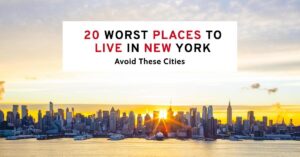Dreaming of New York living? Read this first! Let's dive in to reveal the worst places to live in New York you might want to skip (or research more) before moving.
New York! The land of dreams, towering skyscrapers, and…maybe not the perfect place for everyone? Whether you're a young professional seeking career opportunities, a family looking for top-rated schools, or a retiree on a fixed income, New York offers a diverse range of experiences. However, not every city or town caters to all lifestyles.
There are some locations that might not be ideal for every resident. Some areas are known for their bustling energy and cultural attractions, while others offer a more peaceful, small-town atmosphere. It all comes down to finding the perfect place that aligns with your priorities and budget.
New York is a melting pot of opportunities, but figuring out your priorities is key. While some areas boast electric nightlife and Broadway shows, others might come with a budget-busting cost of living or safety concerns.
To create this not-so-glamorous list, Money Inc. scoured through mountains of data, including crime reports, public school rankings, and even resident reviews. They focused on factors like:
- Crime rates (not just the scary stuff, but property damage too)
- How well the schools are doing
- Job market muscle – unemployment rates
- Entertainment options (exciting stuff because all work and no play…)
- Can you afford a slice of pizza (and rent)?
There's also this video highlighting places in New York to consider avoiding. It's important to remember these might be subjective opinions. Hold on a sec! This list isn't meant to rain on your parade. Every place has its own charm, and what might be a drawback for some could be a perk for others.
Let's Explore…or Maybe Not?
Now, let's unveil the 20 places in New York that might not be ideal for everyone. We'll highlight some of the challenges, but remember, there are always two sides to the coin. Remember, “worst” is relative – what might be a drawback for some could be a perk for others! We'll highlight potential downsides, but keep in mind, there's always a flip side to the story. So use this as a jumping-off point, not a dealbreaker.
20 Worst Places to Live in New York
20. New York City:
The Big Apple for a reason! But that shiny reputation comes with a hefty price tag. Sky-high rents and a job market where everyone's hustling can make settling in tough. Plus, crime rates can be a concern in some areas.
But wait! NYC offers unmatched cultural experiences, world-class eats, and a contagious energy that's hard to resist. Plus, the subway system makes getting around a breeze.
19. Goshen:
This charming town oozes history, but job opportunities might be scarce. The cost of living, especially housing, can be high compared to local wages.
The bright side? Nature enthusiasts rejoice! Goshen boasts beautiful parks and green spaces. And for families, the highly-rated public schools are a big win.
18. Jamestown
Jamestown may not be the safest place to call home, with property crime and violent offenses plaguing the area. Job prospects are also limited.
On the other hand, Jamestown boasts affordability and a strong sense of community. Families will appreciate the highly-rated schools and abundance of kid-friendly activities.
17. Monroe
While Monroe offers a charming small-town atmosphere, its high crime rates and cost of living may be deterrents.
However, Monroe boasts excellent public schools and a variety of family-oriented attractions, like wineries and parks.
16. Albion
This quaint village faces economic challenges with a weak job market and low median home values. Crime rates are also a concern.
Despite these drawbacks, Albion offers a peaceful atmosphere with decent schools and recreational activities for residents.
15. Wappingers Falls
While crime isn't a major issue, Wappingers Falls struggles with a dwindling population and limited employment opportunities. The cost of living can be high compared to income levels.
On the positive side, Wappingers Falls offers beautiful green spaces and a peaceful environment.
14. Brockport
This village boasts a strong sense of community and above-average schools. However, a significant portion of the population lives below the poverty line, and the unemployment rate is higher than average.
Despite these economic challenges, Brockport offers a variety of entertainment options and a friendly atmosphere.
13. Endicott
Endicott has a struggling economy with limited job options and a low median household income. The median home value is also one of the lowest in the state.
A positive aspect is Endicott's proximity to beautiful natural areas and outdoor activities.
12. Poughkeepsie
Poughkeepsie's economic woes are a major concern, with a high poverty rate and unemployment. Crime rates have also risen in recent years.
However, Poughkeepsie boasts a beautiful location near the Catskill Mountains and offers some historical charm.
11. Monticello
Monticello holds the dubious distinction of having the worst unemployment rate in New York. Entertainment options are limited, and the cost of living can be high for some residents.
On the plus side, crime rates are relatively low in Monticello.
10. Binghamton
Binghamton is often cited as one of New York's most dangerous cities. Economic opportunities are also limited, with a high unemployment rate.
However, Binghamton offers some redeeming qualities, including affordable housing, above-average schools, and a vibrant nightlife scene.
9. Watertown
Watertown struggles with poor public schools, a lack of job opportunities, and a high crime rate.
Despite these challenges, Watertown offers a vibrant nightlife scene, diverse community, and affordable cost of living.
8. Utica
Utica's safety is a major concern, with a high crime rate. The job market is also weak, and the housing market reflects a lack of demand in the area.
However, Utica boasts a low cost of living and has some cultural attractions like museums and breweries.
7. Albany
Albany's crime rates are a concern, particularly in certain neighborhoods. The school district is not top-rated.
However, Albany offers the excitement of a capital city with government buildings and corporations. The cost of living is lower than the state average.
6. Newburgh
Newburgh is notorious for its crime rates, some of the highest in the state. Job opportunities are scarce, and the poverty rate is high.
A positive aspect is Newburgh's potential for development. There are ongoing revitalization efforts, and the waterfront location offers scenic beauty.
5. Schenectady
Schenectady struggles with crime rates and a weak job market. The schools are not highly rated either.
However, Schenectady boasts a lower cost of living compared to other parts of the state and has a revitalized downtown area with museums and entertainment options.
4. Niagara Falls
While the iconic falls are a major attraction, Niagara Falls struggles with a high poverty rate and limited job opportunities. Crime rates can also be a concern.
However, Niagara Falls offers a low cost of living and, of course, the awe-inspiring natural wonder of the falls themselves.
3. Syracuse
Syracuse isn't shy about its problems. Crime rates, particularly violent crime, are a major concern. The poverty rate is also high, with over 30% of residents struggling financially.
On the bright side, Syracuse boasts a growing population and a decent job market, particularly in manufacturing and service sectors. The cost of living is lower than the national average.
While excitement might be lacking, Syracuse offers some staples like farmers markets and golf courses.
2. Rochester
Crime rates, both property and violent, plague Rochester. Job opportunities are scarce, with a higher than average unemployment rate and a lower than average household income. The cost of living reflects this economic reality.
However, Rochester shines in education. Public schools are above average, and the city boasts prestigious institutions like the University of Rochester and Rochester Institute of Technology. Museums, parks, and a vibrant college scene add to the city's appeal.
1. Buffalo
Buffalo takes the unenviable top spot on our list. Violent crime, harsh winters with heavy snowfall, and a struggling public school system are major drawbacks.
Looking for a silver lining? Buffalo offers a variety of entertainment options, including The Buffalo Zoo, historical landmarks designed by Frank Lloyd Wright, and renowned art galleries. The city is also known for its delicious chicken wings and passionate sports fans (Go Bills!).
While this list highlights some challenges, remember, that every place has its unique charm. Don't be discouraged entirely – use this as a starting point for your research! New York offers a diverse range of experiences, from bustling cities to charming small towns. Consider your priorities, weigh the pros and cons, and explore further. You might be surprised by the hidden gems waiting to be discovered in the Empire State.




